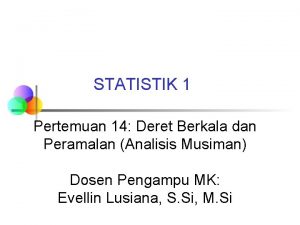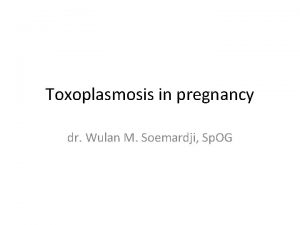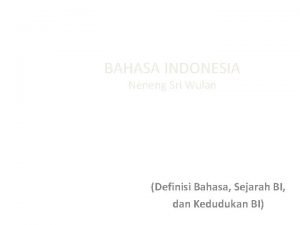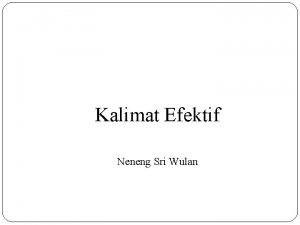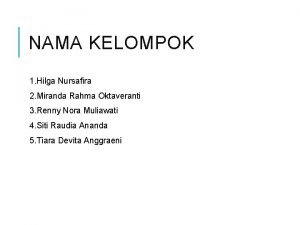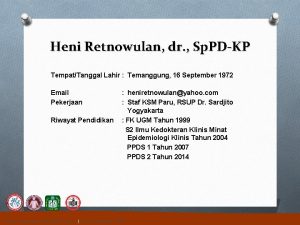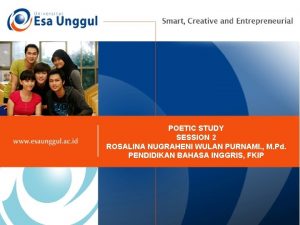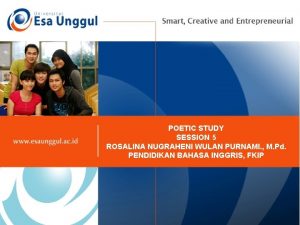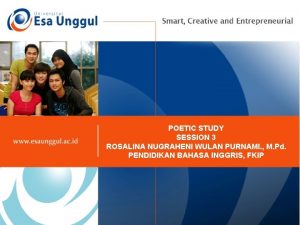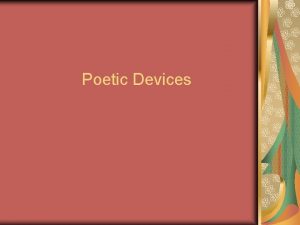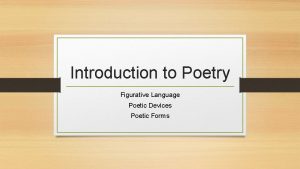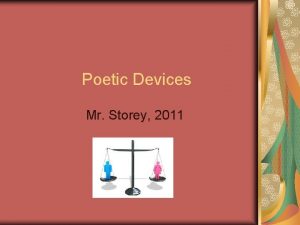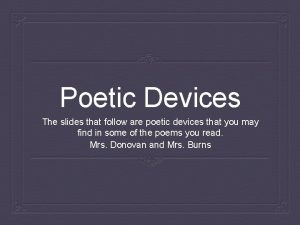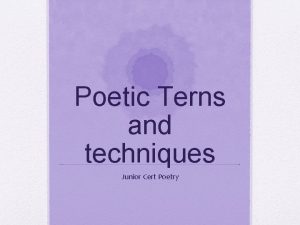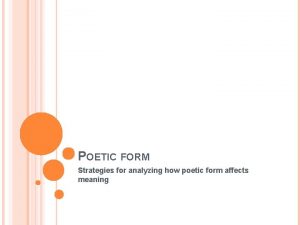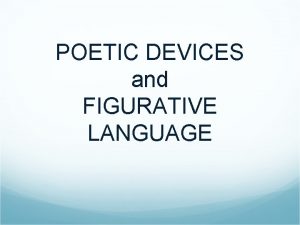POETIC STUDY SESSION 4 ROSALINA NUGRAHENI WULAN PURNAMI
















- Slides: 16

POETIC STUDY SESSION 4 ROSALINA NUGRAHENI WULAN PURNAMI. , M. Pd. PENDIDIKAN BAHASA INGGRIS, FKIP

Genre/Form of Poetry: Lyric & Narrative

LEARNING OUTCOME • Students are able to explain what Lyric Poetry is. • Students are able to explain what Narrative Poetry is.

LYRIC ◦ A type of brief poem that expresses the personal emotions and thoughts of a single speaker or describes something. ◦ It is important to realize that the lyric is in the first person (“I”), the speaker is not necessarily the poet. ◦ The lyrics includes all the shorter forms of poetry: sonnet, elegy, ode, pastoral ◦ The subject matter is expressive, whether of personal emotions, such as love or grief, or of public emotions, such as patriotism or reverence or celebration.

◦ From the point of view of the Lyric, the most important functions of the language are the poetic and the emotive, because these two permit the author to show emotions when an aesthetic language is used. ◦ The poetic function is the ability to manipulate language in a creative way. The poet uses rhetorical figures (similarity, metaphor, etc. ) and style. It’s subjective because represents the creative and aesthetic part of the poem. ◦ The emotive function is centered in the sender, which is the lyric subject or poetic voice, and manifests emotions, feelings, worries, etc. through the poem.

An example of a Lyric poem It was in June you passed me by It was in June you caught my eye Soon we were meeting both day and night The days suddenly seemed filled with light It was all so sudden, a short tryst I thought But your heart and soul it seemed I had caught No, there are no regrets since you walked my way No, there are no regrets since we met that day Those cheesy walks along the beach still fill my mind Those cheesy lines you always managed to find Only you could get away with such things But happiness and joy you seemed to bring A holiday in the sun went by in a dream Moving in seemed the logical thing No, there are no regrets since you walked my way No, there are no regrets since we met that day Who would have known what lay behind the door Who would have thought we would soon be no more When you departed you left a hole too big to fill Even after these many years I miss you still Although I have moved on, I still feel you near Sending me your best, and filling me with cheer No, there are no regrets since you walked my way No, there are no regrets since we met that day

ODE • “Ode” comes from the Greek aeidein, meaning to sing or chant, and belongs to the long and varied tradition of lyric poetry. • Originally accompanied by music and dance, and later reserved by the Romantic poets to convey their strongest sentiments, the ode can be generalized as a formal address to an event, a person, or a thing not present.

SONNET ◦ From the Italian sonetto, which means “a little sound or song, " the sonnet is a popular classical form that has compelled poets for centuries. ◦ Traditionally, the sonnet is a fourteen-line poem written in iambic pentameter, which employ one of several rhyme schemes and adhere to a tightly structured thematic organization. ◦ Two sonnet forms provide the models from which all other sonnets are formed: the Petrarchan and the Shakespearean. ◦ The Petrarchan sonnet consists of an octave (eight lines) and a sestet (six lines). ◦ The Shakespearean sonnet consists of three quatrains (four lines each) and a couplet (two lines). ◦ In Spanish, the sonnet consists in two quatrains and two tercets.

William Shakespeare was baptized on April 26, 1564, in Stratfordupon-Avon, England. From roughly 1594 onward he was an important member of the Lord Chamberlain’s Men company of theatrical players. Written records give little indication of the way in which Shakespeare’s professional life molded his artistry. All that can be deduced is that over the course of 20 years, Shakespeare wrote plays that capture the complete range of human emotion and conflict.

ELEGY • a poem or song in the form of elegiac couplets, written in honor of someone deceased. It typically laments or mourns the death of the individual. • derived from the Greek work “elegus”, which means a song of bereavement sung along with a flute. • The forms of elegies we see today were introduced in the 16 th century. “Elegy Written in a Country Churchyard” by Thomas Gray and “When Lilacs Last in the Dooryard Bloom’d” by Walt Whitman are the two most popular examples of elegy.

ELEGY O Captain! my Captain! our fearful trip is done, The ship has weather’d every rack, the prize we sought is won, The port is near, the bells I hear, the people all exulting, While follow eyes the steady keel, the vessel grim and daring; But O heart! O the bleeding drops of red, Where on the deck my Captain lies, Fallen cold and dead. (“O Captain! My Captain!” by Walt Whitman, 1891)

NARRATIVE • Narrative poetry tells stories through verse. Like a novel or a short story, a narrative poem has plot, characters, and setting. Using a range of poetic techniques such as rhyme and meter, the narrative poet presents a series of events, often including action and dialogue. • In most cases, narrative poems have only one speaker—the narrator—who relates the entire story from beginning to end. For example, Edgar Allan Poe's "The Raven" is narrated by a grieving man who, over the course of 18 stanzas, describes his mysterious confrontation with a raven and his descent into despair.

• Narrative poetry presents a series of events through action and dialogue. • Most narrative poems feature a single speaker: the narrator. • Traditional forms of narrative poetry include epics, ballads, and Arthurian romances.

BALLAD ◦ A relatively short narrative poem, written to be sung, with a simple and a dramatic action. ◦ The ballads tell of love, death, the supernatural, or a combination of these. ◦ Two characteristics of the ballad are: incremental repetition and the ballad stanza. ◦ Incremental repetition repeats one or more lines with a small but significant variations that advance the action. ◦ The ballad stanza is four lines; commonly, the first and third lines contain four feet or accents, the second and fourth lines contain three feet.

EPIC • Traditionally, an epic poem is a long, serious, poetic narrative about a significant event, often featuring a hero. • Before the development of writing, epic poems were memorized and played an important part in maintaining a record of the great deeds and history of a culture. Later, they were written down and the tradition for this kind of poem continued. • Epics often feature the following: a. a hero who embodies the values of a culture or ethnic group; b. something vital that depends on the success of the hero's actions; c. a broad setting, sometimes encompassing the entire world; intervention by supernatural beings. Examples of epics include Gilgamesh, the Odyssey, and Beowulf.

Assignment
 Dr magda rosalina hutagalung
Dr magda rosalina hutagalung Destri budi nugraheni
Destri budi nugraheni Metode rasio rata-rata bergerak
Metode rasio rata-rata bergerak Dr. wulan m. soemardji spog
Dr. wulan m. soemardji spog Neneng wulan
Neneng wulan Dr. wulan m. soemardji spog
Dr. wulan m. soemardji spog Neneng wulan
Neneng wulan Unsent message to wulan
Unsent message to wulan Synclitismus
Synclitismus Neneng wulan
Neneng wulan Dr heni retno wulan
Dr heni retno wulan Dr wulan spog
Dr wulan spog Dr. wulan m. soemardji spog
Dr. wulan m. soemardji spog Roro retno wulan
Roro retno wulan Phytogeographical regions
Phytogeographical regions Retrospective cohort study vs prospective cohort study
Retrospective cohort study vs prospective cohort study Case series
Case series


